




Lewiston City Library to host ‘Caregiving’ documentary screening / PAGE 8











ON THE COVER: This photo courtesy of Ark Media shows the hands of husband and wife, Matt and Kanlaya Cauli. They are featured in the documentary “Caregiving,” which will have a screening at the Lewiston City Library. The story is on Page 8. TIMES
MAY BIRTHDAYS: Anna Marie Eier and ClairBelle “Katie” Greer, onPage 3.
EDITOR: Dallas Marshall, (208) 848-2232/ dmarshall@lmtribune.com
SUBMISSION DEADLINE for the June issue is 5 p.m. May 15. GOLDEN TIMES: P.O. Box 957, Lewiston, ID 83501 goldentimes@lmtribune.com


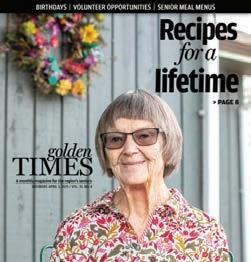




>MAY 20
Marie Eier, 98
Anna Marie Eier, of Lewiston, was born May 20, 1927, in Cheyenne, Wo. She grew up near Sandpoint, Idaho. Marie is the oldest child of J.B. and Opal Whitehead. She moved to Lewiston in 1944.

She was a registered nurse at St. Joseph’s Hospital in Lewiston for 30 years.
Her hobbies include reading books and The Lewiston Tribune. She is a member of the retired nurses group, ladies group at the Congregational Presbyterian Church and Republican Womens Group.
She married Douglas S. Eier on Sept. 21, 1962, in Lewiston. He died Aug. 9, 2005. She has seven children, 16 grandchildren, 15 great-grandchildren and three great-great-grandchildren.
Her family will hold an open house birthday celebration in Marie’s honor from 2-5 p.m. May 20 at 1403 15th Ave., Lewiston.
>MAY 30
Katie Greer, 90
ClairBelle Fay “Katie” Lang was born May 30, 1935, to Morris and Barbara Lang in Cloverland. She has lived in Asotin all of her life.

In 1949, she married Bill Greer and they have been married 76 years. They have four children: Barbara Jane Greer (Bobby) Raspone, Betty Louise GreerWeissenfels, Bonniabelle Kay GreerGrieve and the late Billy Morris Greer. Katie got her GED a er her children were raised. She attended beauty school and got her beautician license. She enjoyed doing her friends’ and family member’s hair.

She loves to attend car shows in her white convertible 1967 Ford Mustang and is a member of the Eagles and Moose lodges. She belonged to the Red Hat Society and goes to Wednesday morning co ee at Rosauers. She also loves to make quilts to enter in the Asotin County Fair. If you know her, give her a call and wish her a happy birthday.
To submit birthdays: Birthday announcements starting at age 70 are accepted for free publication in the month of the birthday only. Length limit is 200 words. All submissions must include the name and contact information of the person submitting the announcement. Current photos are welcome — please no dated pictures. To have photos returned, please include a stamped, selfaddressed envelope. Submissions may be sent to goldentimes@lmtribune.com or Golden Times, P.O. Box 957, Lewiston, ID 83501. Questions may be directed to editor Dallas Marshall at dmarshall@ lmtribune.com or (208) 848-2232. June birthday announcements must be received by 5 p.m. May 15.








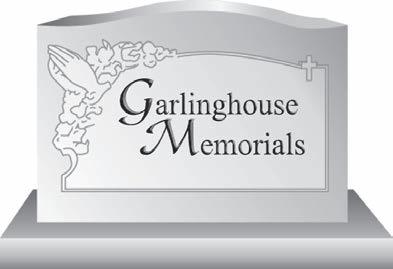


















For the LewistonClarkston Valley
> Monday-Friday Co ee, 9:30-11:30 a.m. to noon, Valley Community Center, 549 Fi h St., Clarkston.
> Monday, Wednesday, Friday Co ee, 10 a.m. to noon, $1 donation, Sixth Street Senior Center, 832 Sixth St., Clarkston.
Fit and Fall Proof, 9-9:45 a.m., Congregational Presbyterian Church, 709 Sixth St., Lewiston.
Fit and Fall Proof, 10:4511:30 a.m., Orchards United Methodist Church, 1213 Burrell Ave., Lewiston.
> Mondays and Wednesdays
Yoga/low-impact exercise, 9-10 a.m., Valley Community Center.
> Mondays and Thursdays
S.A.I.L. (Fit & Fall




Prevention) class, 10:30-11:30 a.m., Valley Community Center.
> Mondays and Fridays
Fit and Fall Proof, 10-11 a.m., Emmanuel Baptist Church, 2200 11th Ave., Lewiston.
> Mondays
Painting group, noon to 4 p.m., Valley Community Center.
Dance practice, 6-7:30 p.m., Sixth Street Senior Center.
> Tuesdays Bingo, 2-4 p.m., Valley Community Center.
> Tuesdays and Thursdays
Fit and Fall Proof, 8:15-9:15 a.m., Elks Lodge, 3444 Country Club Drive, Lewiston.
> Wednesdays
Bingo 10-10:45 a.m.,
11 a.m.-1 p.m., Sixth Street Senior Center.
Bridge, 12:30-4 p.m., Valley Community Center.
Line dancing, 2 p.m. and 3:15 p.m., Sixth Street Senior Center.
Zumba, 5:30 p.m., Sixth Street Senior Center.
> Thursdays
Footcare, Valley Community Center. By appointment only: (253) 218-7091.
Line dancing, 10:30 a.m., Sixth Street Senior Center.
Card games, 1-3 p.m., Valley Community Center.
> Fridays Country jam, 10 a.m. to noon, Sixth Street Senior Center.
> Sundays
Dance lessons, 2 p.m. and 5 p.m., Sixth Street Senior Center.

> May 7
Board games/cards, 3-4:30 p.m., Valley Community Center.
> May 9
CHAS Mobile Unit, 10 a.m.-1 p.m., Valley Community Center.
> May 15 and 29
Dance and covereddish dinner, 6 p.m., Sixth Street Senior Center.
> May 13 and 27
Foot care, Valley Community Center. By appointment only: (253) 218-7091.
Karaoke, 6:30-9 p.m., Valley Community Center.
> May 17 Sons of Norway, 12:30-3 p.m., Valley Community Center.
> May 26
Seaport Quilters, 6-9 p.m., Valley Community Center.
> May 30
Syringe/needle disposal, 10:30 a.m.-12:30 p.m., Valley Community Center.
To submit your event for the senior calendar, email goldentimes@lmtribune.com. For more information about events at the Sixth Street Senior Center, see the calendar at sixthstreetsrcenter.com.





































WA-ID Volunteer Center, in the Lewiston Community Center at 1424 Main St., strives to provide individualized volunteer opportunities for those wishing to serve in Lewiston, Clarkston, Asotin, Pomeroy, Moscow and the Oro no area. Information and other volunteer openings can be found at waidvolunteercenter.org or by calling (208) 746-7787. Volunteer needs include:
Thri Store — Volunteers are needed to help clean merchandise and shelves and price tag items.
Food bank help —
Volunteers are needed to repack frozen and dry foods for distribution. Front counter volunteers and drivers for morning food pickups also are needed.
Tutors — Help students to be pro cient readers by the third grade. Oneon-one reading tutoring in schools for students below reading grade level. Volunteers need to be able to commit to at least an hour a week for the school year. Background check required.
Project Warmup — Cra ers are needed to make hats, scarves, mittens and lap blankets (yarn is provided).
Completed items are donated to local nonpro t agencies. If you have yarn to donate, our volunteers will put it to good use.
Companions — The Senior Companion program provides companionship and respite care to the elderly and disabled. It allows low-income senior volunteers an opportunity to assist those who need minor help to continue living independently. Senior Companions visit clients in their homes, but it is not an in-home care program.
Medicare counselor — The State Health Insurance Bene ts
Advisors (SHIBA) program trains volunteers to assist local seniors with Medicare questions for Asotin, Gar eld and Whitman counties.
Local hospital auxiliary — Volunteers are needed to greet people, deliver owers, sta the courtesy cart, deliver mail, assist in the gi shop, create baby and child items, do clerical work, provide hospital tours and more.
Lewiston City Library — Volunteer needs include circulation support, tech tutors and programming support.
approved.
Habitat for Humanity — Help with home construction/renovation, remote grant writing/ research and helping at the Habitat store.

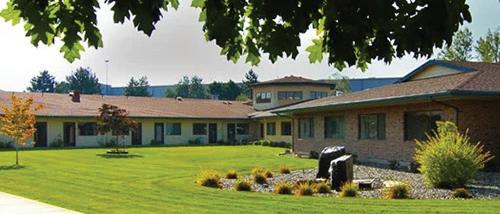





Museum docents — Skills include meet-andgreet abilities, friendly personality and the ability to answer questions about the displays at the center. Training is provided.
Meal sites — Volunteers are needed for regular and substitute meal delivery drivers. A valid driver’s license and auto insurance are required.
Interlink Inc. is a nonpro t organization in Clarkston that matches community volunteers to people needing assistance to remain independent in their own homes. For information about becoming a volunteer and volunteer opportunities, call (509) 751-9143. Volunteer applications and additional information also can be found online at interlinkvolunteers.org. Volunteer needs include:
l Drivers to transport senior citizens to appointments. Drivers are paid a mileage stipend.
l People who can do small home safety repairs for senior citizens and persons with disabilities.
l Volunteers interested in serving as volunteer helpers in the Interlink o ce.

Garden and parks — General lawn maintenance, weeding and sweeping, etc. Training provided. Community service
l Volunteers willing to help compile a senior social directory.







Pre-planning your final wishes gives you and your family peace of mind. Whether cremation or burial - we are proud to offer a variety of options for every budget.


hildren growing up in the 1940s or ’50s had to learn to entertain themselves without television or electronic games. That was my experience and I wonder if it was yours also.
Any ball became useful for a game we made up that entailed drawing lines in the dirt and tossing a ball into a wooden slatted basket with wire handles. The ball had to land and stay in the basket and you got extra points for extra distance.
I don’t remember having a real baseball, but I do remember that any vacant lot became a eld to play. We didn’t own mitts, but sticks were bats and cardboard squares were bases. The oldest among the players usually was the umpire when a disagreement arose. It didn’t matter if the pitch was overhand or underhand if it crossed the plate. I learned to slide just like the boys.
GALLIVANTING GRANNY
I used to play marbles, too, and could beat my little brother until he got a steelie. In hindsight, I think it was nothing more than a steel ball bearing, but he could knock my marbles o course and sometimes chipped them.
Most of my girlfriends also played jump rope and we even tried double Dutch with two ropes. It was a bonus if you could jump and turn or hop on one foot. We’d count how many times we could skip the rope before a miss.
A Mason jar with holes in the lid played a role in my eld explorations. I’d catch insects in the jar and examine them from every angle. Grasshoppers with red wings were fun to chase and a challenge to capture. Mother wasn’t thrilled when I showed her the black widow spider I’d caught and was mesmerized by its red belly pattern.
A creek or pond was an invitation to wade or sh. We turned over rocks to see what lurked beneath; caught tadpoles, frogs, cray sh and even a few sh with poles made from any stick and a bit of line.
Our bicycles were adorned with playing cards to make a clicking sound as we rode and we were allowed to roam until we felt feral. The swimming pool was a favorite in summer and we passed a park with rings, monkey bars and swings. We’d twist ourselves around in those swings to spin in circles and then compete to see who could swing the highest and then jump o . Games of hopscotch and ball and jack were favorites with girls while most of the boys played marbles.
If we were lucky, we might ush out quail or a deer for an extra thrill.
I should be better at math for all the games we played where we kept score. Our family played pinochle, old maid, hearts and cribbage. Dominoes and Chinese checkers were also favorites.
I haven’t outgrown the fun of blowing bubbles, but we didn’t have fancy equipment, just a loop and a breath.
Trading comic books was almost a sport. One with an unblemished cover was a more valued trade, as was the newest edition. I remember loving Donald Duck and Da y Duck, Woody Woodpecker and Bugs Bunny. The newspaper carried the Lil’ Abner comic strip that we rushed to read.
Grandmother nally got a television set and we would plead to watch cartoons like “Tweety Bird” and “Tom and Jerry” instead of “The Lawrence Welk Show” and wrestling. Once a month, we got to go to the movie matinee on Saturday. We were supposed to use our dime to catch the bus, but we’d sometimes hitchhike and use the dime for a pocket full of penny candy.
I guess that freedom in youth gave me a greater appreciation for nature, where I still nd peace and joy. Thanks for traveling with me on a walk down memory lane.
Christiansen lives in Lewiston. She can be reached at petpal535@gmail.com.
Just a dog, you say? No, he was much more than that. He was my psychiatrist. I would talk over my care, worries and my problems with life to him. He didn’t answer, but his eyes held complete understanding.
relative, he didn’t care that I held on tight to him and cried an ocean of tears all over him.
Rose Gatherer
He was my pal. Not too many pals would take a running start and jump o a dock into cold lake water with me. Then when I got dry, jump in again, get out and shake beside me, then look at me with a silly, doggy grin, as if to say, “I got ya.” He was a companion. When I lost a close
Come&Blossom withUS!
He was my physical therapist. Oh, the miles of walking side by side. We would even play hide and seek with the kids in the park.
Last of all, before I got him, he was a hero. He saved countless servicemen and servicewomen overseas by sni ng out land mines and roadside bombs.
No sir, he was all these things. Plus a whole lot more. But he was never, ever, just a dog.
Gatherer, 79, lives in Asotin.


*CableandWIFI*Maintenance*3 MealsPerDay*HairSalon*Climate ControlledUnits*Housekeeping *Snacks*Library*FitnessArea* Laundry*MonthtoMonthLease *Chapel*FullSocialCalander *DogParkComingSoon!
“INDEPENDENCE WHEN YOU WANT IT, ASSISTANCE WHEN YOU NEED IT.”
JoinusforMayFamilyFun Day! May29that3:00PM Tie-DyeT-Shirts FoodandDrinksProvided GamesforChildren LiveMusic GoodieBagsandMore!



time in the past 12 months.
A report by AARP estimated that in 2021, 38 million family caregivers provided on average 18 hours or care per week, of a collective 36 billion hours of care.
Those family caregivers include an estimated 5.4 million children who support parents, grandparents, siblings and other family members, according to a Report on Caregiving Youth in the U.S. by the Caregiving Youth Institute.
Holcomb said it’s also not uncommon to see grandparents taking care of grandchildren.
Nationally, as of 2021, 2.1 million grandparents in the U.S. were primary caregivers

for their grandchildren, according to the American Society on Aging.
“There’s a gap in our conversation around grandparents taking care of grandkids. It’s not high on our radar,” he said. “We’re not having this conversation as regularly as I think is really happening here. So I would love to see that get picked up.”
Attendees can RSVP at nwpb.org/caregiving.
Sun may be contacted at rsun@ lmtribune.com or on Twitter at @Rachel_M_Sun. This report is made in partnership with Northwest Public

helps wife, Kanlaya, do physical therapy as she recovers from a stroke and cancer. Both are featured in the documentary “Caregiving.”
ABOVE: Tracy Eacret, primary caregiver to her ailing father, John, greets him during their morning routine.
LEFT: Kim Olloz, featured in “Caregiving,” takes her daughter, Charlotte, for a walk in a park in New York City.
This is Part 2 of the column about Lewiston High School sweethearts who stayed together for life. Part 1 can be found at lmtribune. com.
Dixie Parsley graduated in 1949 and met Bengal football star Gerald Peterson of the 1947 class. They were married in Lewiston in 1951 and she was a travel agent while Gerald operated his dental lab business in Boise, where they lived near their two sons, before they died.
Two of my best friends were 1951 classmates: Bill Stellmon and Marlene Haag. They were married in Lewiston in 1954, and I was their best man. When I think of it, I realize it was a North Lewiston, Weaskus Grade School girl marrying an East Lewiston, Gar eld School boy. Bill and I became lifetime friends starting in h grade, when we played on the Gar eld School so ball team, and through high school to the state champions in 1950.
An irony in this article is that my beloved late wife Barbara went to Weaskus Grade School with Marlene. Marlene was an honor society student and had known since she was little that she wanted to be a nurse. She did, in fact, become a nurse. A er graduating, she and Bill were married and spent the next two years in the Marine Corps because he was a U.S. Marine. Their 60 years together started in October of 1960, when Bill took her to a movie. When he asked her to go with him to the movie, she said, “Uh, yeah, I guess so,” while thinking, “Would I like to go out with Bill Stellmon, president of the student body, captain of the football team? Would I ever!” There was never anyone else for either of them a er that. A er 56 years of marriage, Bill died Dec. 18, 2010. They

had ve children, 24 grandchildren and many great-grandchildren.
Janette Rawls and Betty Faris were good friends of mine at LHS. They graduated in 1952. They were great girls who were involved in many activities. They were neat, cool and funny, good-looking and fun to be around. Janette was involved in music and the band and a cappella choir, and was Lewiston High School’s girls state representative in Boise. Betty was a writer for the student newspaper, the Bengal’s Purr, and a very good tennis player who continued to play all of her life.

Both Janette and Betty married their high school boyfriends, Jim Wilber and Ron Webb, who were very good athletes. The couples did the normal things at LHS, like hanging out with friends, going to ball games, the Youth Activities Club and going out for burgers.
Ron was voted the top athlete in 1952 as a basketball player and great le -handed pitcher, when I was his catcher. They both graduated from Washington State University and then Ron played pro baseball before coaching high school in California and Spokane. He died in 1991 at age 52. A few years ago, their three children and 10 grandchildren all lived in Spokane, and Betty still has her sense of humor.
Janette was born and raised in Lewiston and attended Webster Elementary School before going to LHS. Jim Wilber was born and raised in the U.S. South before moving to Lewiston, where his dad became the manager of the new paper mill. When Janette met Jim, she loved to hear him talk because of his Southern drawl. Jim played football, basketball and baseball. Janette was in the Kappa Kappa Gamma sorority at the University of Idaho before graduating in 1956. Jim graduated from the U.S. Naval Academy of Annapolis, Md., in 1957 and they were married that year. He had a distinguished 30-year career in the U.S. Navy. After retirement, he worked for the Idaho Human Rights Commission. Janette now lives in Boise. She and Betty are still friends.
Joan Baldeck was born and raised in Lewiston in a Catholic family of doctors and lawyers, and she still lived in the house she grew up in along Third Street. Her dad, brother and uncle are doctors and her husband was Jack Hogan, a dentist. He was an All-American high school football player on the LHS unbeaten 1954 team. He and Joan were both popular students. A er attending the UI, they married and Jack went to Northwestern’s Chicago Dental School. He was a Lewiston dentist and she was a counselor at Lewiston schools. They had four children. Jack has died, but Joan still lives in Lewiston.
Carol Edwards attended McGhee Elementary School in Lewiston and
graduated from LHS in 1958. At LHS, she was in the a cappella choir, on the drill team and was a bowler. She was friends with Gary Walker’s sister, Bits, who was going steady with Andy Klemm. Gary and Carol were married in 1959 in Lewiston, with her sister Joyce and Andy Klemm as maid of honor and best man. Gary worked for Erb Hardware in Lewiston and Carol worked for Pepsi-Cola in Lewiston. They have two daughters and ve grandchildren.
Marian is Bits Walker’s rst name, but she has always been called Bits. She went to McGhee Elementary as a 5 foot-6 inch tomboy. In 1954, as a seventh grader, she met freshman Andy Klemm and they have been “going steady” since 1955. They were both very popular students in their 1958 graduation class. Andy won the Ronnie White award at LHS as the school’s top football player. He was injured at UI and had to quit playing. Bits and Andy married 2 weeks a er she graduated in 1960. Andy began coaching high school football in Oregon where he won many games and state titles. Bits worked her way up in Oregon’s Coos County to the post of county road master. They have three children and nine grandchildren. They have both passed away a er being Bengal sweethearts for nearly a lifetime.
Riggs is a lifelong Lewistonian. He’s an avid Warriors fan, a retired educator, coach and school superintendent and volunteers his time at the Nez Perce County Historical Society. He can be reached at bdriggo@gmail.com.
Atrip to my dentist’s o ce is always delightful. Now wait. Before you say, “Sarcasm doesn’t become you,” I’m sincere. Amazingly, I still have all my own teeth — albeit the back ones are probably worth more in gold than I have in the bank.
I never expected to reach my 80s with my own teeth. I was 5 when my dad had all his teeth pulled (yes, all on the same day). When his gums healed, he used a set of false teeth. Mom did the same thing when I was 12. It was just the thing to do in the 1940s. I considered it the normal process of aging.

I grew up in the Lewiston Orchards. Our water supply came from Waha Lake, channeled down to Mann Lake, then pumped to homes. In the spring, when the water rapidly owed from the melting snow, Mom kept cheesecloth tied around the spigot. Every night, she took the old cheesecloth o and tied on a clean square. The old one was full of mud, gravel, snails, tadpoles, little



sh and sometimes even little frogs. It was quite a biology lesson. Our house water and irrigation water were all the same. I learned not to drink out of the hose in the spring. The Orchards grew in population. The Lewiston Orchards Irrigation District board decided a ltration plant was needed. The price of water was raised and a plant was built in the middle of a wheat eld east of Powers Avenue. I was in the sixth grade. It was a big event. Mr. Johnson took us students on a eld trip to learn how it worked. It’s still there today. What does all this have to do with my teeth? Well, teeth need uoride to become strong and healthy. It was added through the plant, but it was too late to rescue my baby teeth. They were rotten to the core. Many days, I su ered horrible toothaches. The teacher sent me to the school nurse. (Yes, there was a school nurse at the Old Orchards Elementary. She even wore a uniform and one of those cute












little caps) She dipped a swab into clove oil and painted the gum around the tooth, then sent me back to class. The clove oil numbed the pain and I would continue learning.
I only remember losing my two front teeth naturally. When they became loose, Dad tied a string around them. He tied the other end of the string to the kitchen door knob, told me to close my eyes, then slammed the door and out came my teeth. It was like magic. Eventually, my baby teeth rotted. One by one, Dr. Klaren pulled them out.
My permanent teeth weren’t much better. It didn’t help we had no toothpaste — only tooth powder. We only brushed our teeth on Saturday night a er our weekly bath. Dental education was sadly lacking in my family.
During college in Portland, Ore., I was sent to the school’s dentist, to get my wisdom teeth pulled. He did all four on the same day. I thought, “Oh no, it’s begun. It won’t be long till I have falsies.” He educated me on how to take care of my teeth and lled my cavities with silver stu .









When I moved back to the Lewiston-Clarkston Valley, we connected with Dr. Evers. He was up on the latest, educated us on tooth care and replaced my crumbling llings. He joined Dr. Wilson who said, “We’ve got to get rid of the silver in your mouth. It’s not healthy. Your mouth’s health determines the health of the rest of your body.” Tooth by tooth, he replaced the silver with gold.
I just read in “The Aging Brain,” by Timothy R. Jennings, MD, that “Failing to care for one’s teeth increases the risk of developing dementia. Research has found that those with the fewest teeth had the highest risk of prevalence and incidence of dementia. So a simple action to reduce dementia risk is to practice good oral hygiene.”
Regular exams, brushing two times a day, ossing, rinsing ... yes, it all pays o . Dr. Wilson told me last visit, “You have a very healthy mouth and will most likely die with all your own teeth.” That’s why I nd going to my dentist a delightful thing.
Chase Hoseley is a freelance writer and retired kindergarten teacher who lives in Clarkston. She can be reached at shoseley8@gmail.com.

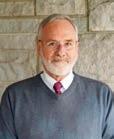
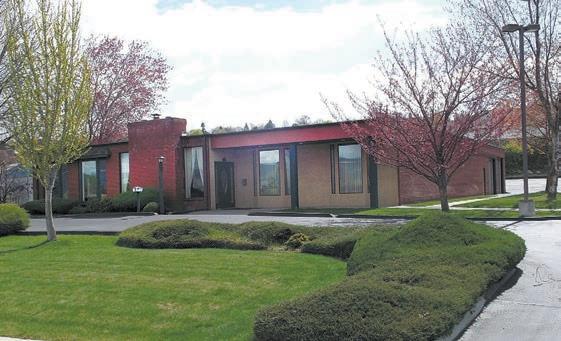

By MATT SEDENSKY ASSOCIATED PRESS
NEW YORK — Michael Montgomery used to check the balance on his retirement account once a week and smile. But lately, not wanting to get upset and question if he could retire in a few years, there was only one solution.
“I’m not looking,” says the 66-year-old professor from Huntington Woods, Mich.
As the White House simultaneously injects turmoil into nancial markets with its trade war and dismisses fears of a downturn, retired and near-retired Americans are anxiously looking on, worried about outliving

their savings or having to put o entries on their bucket lists.
Keeping logged o his account has made Montgomery’s days less worrisome. He and his wife ad-
justed their portfolio a er Election Day, including moving more money into bonds. But he’s not sure what more he can do if the entire world economy can be a ected by deci-
sions in Washington, D.C.
“I hope like hell I don’t lose all my retirement savings,” he says. “But where else could you put the money that these people could not disorder? They can’t get into your mattress but that’s about it.”
Many experts warned U.S. stocks were overpriced and due for a correction even before President Donald Trump reclaimed the Oval O ce. But a historic blanket of tari s have injected new uncertainty into the market.
Though stocks rallied recently, the S&P 500 is down 10% from an alltime high reached in February. Losses in the Nasdaq and among small-cap stocks are steeper. Even bonds and the U.S. dollar

have been volatile. Many economists are warning of a possible recession.
It has 71-year-old Jeanne Oats Estridge feeling so “paranoid” she called her nancial planner with an idea.
“How about we put it all in cash?” Oats Estridge asked.
“I just don’t advise it,” she heard back.
Oats Estridge, who lives in Dayton, Ohio, retired from a job in so ware engineering and now writes books, including her latest about four octogenarian women kidnapped by sex-tra cking aliens. Her account is down more than $40,000 and she gets angry thinking about how some in Washington, D.C., have reacted to the market volatility,
Continued on Page 14






including Trump’s recent market assessment that it was “a great time to buy.”
“Where am I supposed to come up with the money to buy? My underwear drawer?” Oats Estridge asks.
Earlier this month, the Cboe Volatility Index, considered a “fear gauge” of investor pessimism, reached its highest level in ve years. The index, known as VIX, has since retreated but is still in territory re ecting fearful investors. Another measure of market sentiment, the Cboe S&P 500 Le Tail Volatility Index, which tracks investor worry about so-called “black swan” events such as the 2008 housing crash that spurred the Great Recession, likewise has
backed o from highs but remains elevated.
Trump has urged people to “be cool” in assessing the impact of tari s on their investments. Asked about his own savings earlier this month, he chuckled and replied: “I haven’t checked my 401(k).”
Treasury Secretary Scott Bessent, meantime, brushed o the possibility that some might need to delay retiring, saying people “don’t look at the day-to-day uctuations of what’s happening.”
That seeming nonchalance isn’t sitting well with some older investors.
Peter Rost, 72, retired from his so ware development job last year and planned to start tapping his retirement savings to supplement Social Security. But he doesn’t want to
bake in his losses.
“I’m looking to take $2,000 and meanwhile the account drops by $30,000,” he says.
He’s been through serious downturns before, but those were di erent.
“I had the time to be patient and let it work its way back,” says Rost, who lives in New Hartford, Conn., “but now I’m retired and I need money from that account.”
At his age, he says, there’s one goal: “Make sure I don’t run out of money before I die.”
Americans’ retirement savings totaled about $44 trillion at the end of 2024, according to the Investment Company Institute. The composition of those savings has shi ed increasingly toward stocks in the last couple of


•Professional
decades as the 401(k) has become employers’ typical o ering.
Among fund giant Vanguard’s nearly 5 million accounts, for example, the average investor puts three-quarters of their savings in stocks. Even older investors are still heavily steeped in equities: People 55 to 64 have 64% in stocks at Vanguard; those 65 and older have 49% in stocks.
With that exposure, nancial advisers are getting an in ux of calls amid the recent market uncertainty.
Tj Binkowski, who runs Narrow Road Financial Planning in Clarksville, Tenn., says some clients nd themselves obsessively checking their accounts and feel the emotional strain of worrying about
their money. A downturn, he says, hits an older investor much di erently.
“When you’re retired, paper losses aren’t just on paper anymore,” says Binkowski. “You’re locking them in every month that you take money out.”
Paul Duesterhaus, a 68-year-old retiree from Quincy, Ill., is passing up an IRA withdrawal this year to avoid selling at a low. Instead, the retired manager at an air compressor manufacturing company will put o buying a new car as planned and cut back on things like eating out.
Still, he can’t help but feel bigger impacts of a trade war are ahead.
“I think there’s going to be longer lasting e ects that are going to a ect every American,” he says.





That angst is more common among older adults than younger people. An April poll by The Associated Press-NORC Center for Public A airs Research found just under half of U.S. adults ages 45 and older said their retirement savings are a “major” source of stress for them right now, compared to about one-third of younger people. Older Americans were also more likely to say they’re stressed about the stock market.
For now, many older investors are taking the advice of many experts, to ne-tune investments if necessary but avoid dramatic moves. But it can be hard advice to swallow.
“The more things go
up and down, the more nervous you get,” says
Steve Turner, a 74-year-old from Chester eld, Mo., who runs a small public relations business. He now nds himself anxious when he goes to log on to his retirement account, wondering, “Gee, do I want to press the button?”
“You worry that things may work themselves out in the long run, but you don’t have as long,” says Turner. “You’re not 30, you’re not 40, you’re not 50, you’re not even 60.”
Sedensky can be reached at msedensky@ap.org and x.com/sedensky. Associated Press writer Amelia ThomsonDeVeaux in Washington, D.C., contributed to this report.



